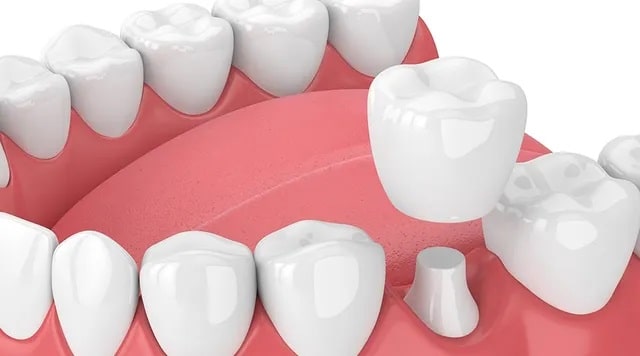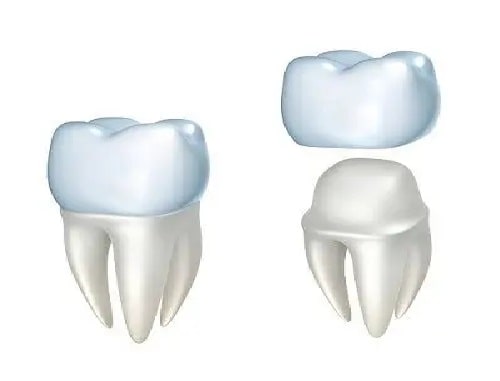While dental crowns have an average lifespan of about ten to fifteen years, each crown is different and may need to be evaluated for replacement or repair earlier than this.
In some cases it is obvious that you need to replace a crown because it has fallen out or suffered extensive damage; in other circumstances, it is less obvious that there is a problem with a crown. Ignoring signs of a problem could end up causing you pain and discomfort.
Dental crown replacement procedure
The procedure generally begins with the removal of the old crown in preparation for a new crown. It is very rare that an old crown can be saved or reused since it will typically need to be cut into sections as it is removed from the tooth. The tooth and gum tissue will be numbed with a local anesthetic during this procedure to make sure the procedure is as painless as possible.
With the old crown removed, the remaining tooth structure will be prepared for a new crown. The tooth may need to be gently reshaped and the dentist will make an impression of the tooth to capture the tooth’s dimensions. If the crown is to be made in an off-site dental lab, the tooth will be temporarily fitted with an acrylic crown for a short period of time.
Here are some signs that your dental crowns should be replaced:
Your Gum Line Is Receding
One of the most common reasons patients head to the dentist to replace old dental crowns is tooth decay. When tooth decay forms under your dental crown, your gums can recede. When this happens, your tooth root surface becomes exposed and can develop a cavity. If your dentist notices that you have tooth decay under your crown, they will either drill a hole into your current crown, or remove your crown to clean out the decay — the same decay removal process used before placing tooth fillings.
You may even need root canal treatment if the decay has infected your tooth’s pulp. Regular teeth cleanings and exams will help your dentist see any decay early and potentially save you from needing a root canal procedure.
You have pain in or around a crowned tooth
While it is very rare for a metal crown to break or chip, porcelain crowns or the porcelain component of a porcelain-fused-to-metal crown can sometimes suffer surface damage due to the wear and tear of everyday use, eating or excessive force caused by bruxism. Broken or cracked crowns may expose the underlying tooth and can cause pain, swelling or tenderness.
In the case of a fractured or damaged crown, it is crucial to restore the crown’s integrity so it can continue to protect the underlying tooth. Depending on the extent of the damage, it may be easily repaired with a quick buffing, or it may require replacement.
Complications with Old Dental Crowns
Sometimes older dental crowns, especially those that were made from an older type of porcelain on front teeth may need replaced as you age. As the dental crown material becomes better outdated tooth crowns crafted with old porcelain that was placed over metal crowns can show up as dark shadows along the gum line. A skilled dentist can replace your old crown with a new, better-quality ceramic crown.
The dental crown is becoming uncomfortable
When your crown is first fitted and placed, your bite should feel completely normal. If, over time, your bite starts to feel uneven, something may have occurred with your crown and it may need to be adjusted or replaced.
Dental crowns can also become loose for a variety of reasons. They can loosen as the result of tooth grinding or clenching that applies a side to side force on the teeth, chewing very sticky foods that can pull on the crown, flossing upwards which can loosen the base of the crown or dental decay that has occurred under the crown. As soon as you notice a loose dental crown, you should call your local dental office immediately for a dental checkup to replace your crown. If your tooth crown eventually falls off, it may be considered a dental emergency so it is best not to wait until that point.
Your dental crown becomes infected
A crown is designed to provide the same protection as the enamel of the tooth. However, this does not mean that infections and cavities cannot occur. In most cases, a crown will need to be removed in order to fill or treat a cavity that has developed in the tooth below.
Where infection of the dentin or pulp has occurred, a root canal will be necessary. The crown will need to be removed so that the infected pulp can also be removed. In most cases, a new crown will replace the one that has been removed.
Where an abscess has occurred, treatment with antibiotics to eliminate the infection will be the first course of action. However, if the infection does not resolve, the crown may need to be removed in order to drain the abscess and treat the infection.
Your feel that your dental crown is no longer Aesthetically Pleasing
In many cases, aesthetics are important to those with dental crowns. Those with porcelain crowns fused to metal may notice a dark line along their teeth, for example, which results from the crown’s metal showing through. If this causes cosmetic concern, a dentist can replace the crown.
Conclusion
Ensuring the longevity and functionality of your dental crowns is paramount for your oral health and overall well-being. Recognizing the signs that indicate the need for crown replacement or repair is essential in preventing further complications and discomfort. From receding gum lines to discomfort and aesthetic concerns, addressing these issues promptly can safeguard your dental health and restore your confidence in your smile.
Take action now to safeguard your smile. Contact us for a dental evaluation today to address any concerns about your dental crown replacement. Your oral health matters—don’t wait, book your appointment now.




